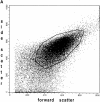Functional imaging of mitochondria in saponin-permeabilized mice muscle fibers
- PMID: 9490722
- PMCID: PMC2132706
- DOI: 10.1083/jcb.140.5.1091
Functional imaging of mitochondria in saponin-permeabilized mice muscle fibers
Abstract
Confocal laser-scanning and digital fluorescence imaging microscopy were used to quantify the mitochondrial autofluorescence changes of NAD(P)H and flavoproteins in unfixed saponin-permeabilized myofibers from mice quadriceps muscle tissue. Addition of mitochondrial substrates, ADP, or cyanide led to redox state changes of the mitochondrial NAD system. These changes were detected by ratio imaging of the autofluorescence intensities of fluorescent flavoproteins and NAD(P)H, showing inverse fluorescence behavior. The flavoprotein signal was colocalized with the potentiometric mitochondria-specific dye dimethylaminostyryl pyridyl methyl iodide (DASPMI), or with MitoTrackerTM Green FM, a constitutive marker for mitochondria. Within individual myofibers we detected topological mitochondrial subsets with distinct flavoprotein autofluorescence levels, equally responding to induced rate changes of the oxidative phosphorylation. The flavoprotein autofluorescence levels of these subsets differed by a factor of four. This heterogeneity was substantiated by flow-cytometric analysis of flavoprotein and DASPMI fluorescence changes of individual mitochondria isolated from mice skeletal muscle. Our data provide direct evidence that mitochondria in single myofibers are distinct subsets at the level of an intrinsic fluorescent marker of the mitochondrial NAD-redox system. Under the present experimental conditions these subsets show similar functional responses.
Figures










Similar articles
-
Measurement of fluorescence changes of NAD(P)H and of fluorescent flavoproteins in saponin-skinned human skeletal muscle fibers.Anal Biochem. 1994 Feb 1;216(2):322-7. doi: 10.1006/abio.1994.1048. Anal Biochem. 1994. PMID: 8179187
-
Laser-excited fluorescence studies of mitochondrial function in saponin-skinned skeletal muscle fibers of patients with chronic progressive external ophthalmoplegia.Biochim Biophys Acta. 1995 Dec 12;1272(3):181-4. doi: 10.1016/0925-4439(95)00085-2. Biochim Biophys Acta. 1995. PMID: 8541350
-
Functional characterization of mitochondrial oxidative phosphorylation in saponin-skinned human muscle fibers.Biochim Biophys Acta. 1993 Aug 16;1144(1):46-53. doi: 10.1016/0005-2728(93)90029-f. Biochim Biophys Acta. 1993. PMID: 8347661
-
Use of NAD(P)H and flavoprotein autofluorescence transients to probe neuron and astrocyte responses to synaptic activation.Neurochem Int. 2010 Feb;56(3):379-86. doi: 10.1016/j.neuint.2009.12.015. Epub 2009 Dec 29. Neurochem Int. 2010. PMID: 20036704 Free PMC article. Review.
-
Use of saponin-permeabilized muscle fibers for the diagnosis of mitochondrial diseases.Biofactors. 1998;7(3):221-3. doi: 10.1002/biof.5520070312. Biofactors. 1998. PMID: 9568252 Review. No abstract available.
Cited by
-
Simple method for the identification of oxidative fibers in skeletal muscle.Eur J Appl Physiol. 2004 Mar;91(2-3):357-9. doi: 10.1007/s00421-003-1035-8. Epub 2004 Jan 21. Eur J Appl Physiol. 2004. PMID: 14735365
-
In Vivo Detection of Rat Colorectal Cancers by using a Dual-Wavelength Excitation Method.Acta Histochem Cytochem. 2014;47(5):247-54. doi: 10.1267/ahc.14043. Epub 2014 Oct 23. Acta Histochem Cytochem. 2014. PMID: 25861131 Free PMC article.
-
Cytoplasmic signaling in the control of mitochondrial uproar?Cell Commun Signal. 2008 Aug 19;6:4. doi: 10.1186/1478-811X-6-4. Cell Commun Signal. 2008. PMID: 18713454 Free PMC article.
-
Statistically strong label-free quantitative identification of native fluorophores in a biological sample.Sci Rep. 2017 Nov 17;7(1):15792. doi: 10.1038/s41598-017-15952-y. Sci Rep. 2017. PMID: 29150629 Free PMC article.
-
Retinal flavoprotein autofluorescence as a measure of retinal health.Trans Am Ophthalmol Soc. 2008;106:215-22; discussion 222-4. Trans Am Ophthalmol Soc. 2008. PMID: 19277237 Free PMC article.
References
-
- Altschuld RA, Wenger WC, Lamka KG, Kindig OR, Capen CC, Mizuhira V, van der Heide RS, Brierley GP. Structural and functional properties of adult rat heart myocytes lysed with digitonin. J Biol Chem. 1985;260:14325–14334. - PubMed
-
- Bereiter-Hahn J, Voth M. Dynamics of mitochondria in living cells: shape changes, dislocations, fusion, and fission of mitochondria. Microsc Res Tech. 1994;27:198–219. - PubMed
-
- Chemnitius JM, Manglitz T, Kloeppel M, Doenst T, Schwartz P, Kreuzer H, Zech R. Rapid preparation of subsarcolemmal and interfibrillar mitochondrial subpopulations from cardiac muscle. Int J Biochem. 1993;25:589–596. - PubMed
-
- Chen LB. Fluorescent labeling of mitochondria. Methods Cell Biol. 1989;29:103–123. - PubMed
-
- Cogswell AM, Stevens RJ, Hood DA. Properties of skeletal muscle mitochondria isolated from subsarcolemmal and intermyofibrillar regions. Am J Physiol. 1993;264:C383–C389. - PubMed
Publication types
MeSH terms
Substances
LinkOut - more resources
Full Text Sources
Other Literature Sources

